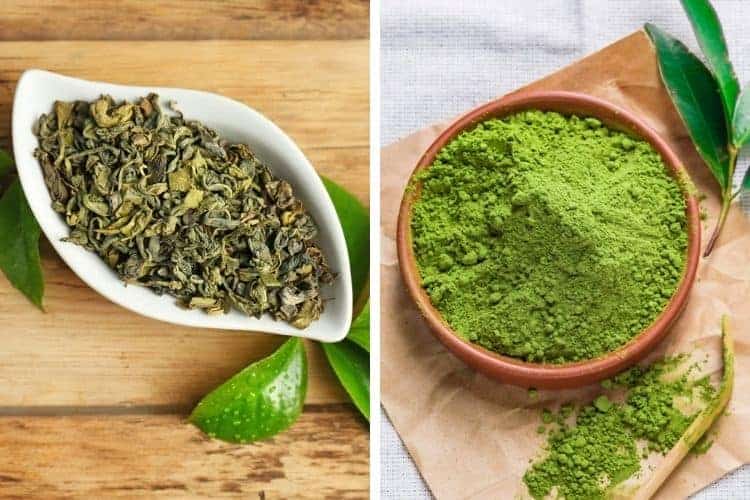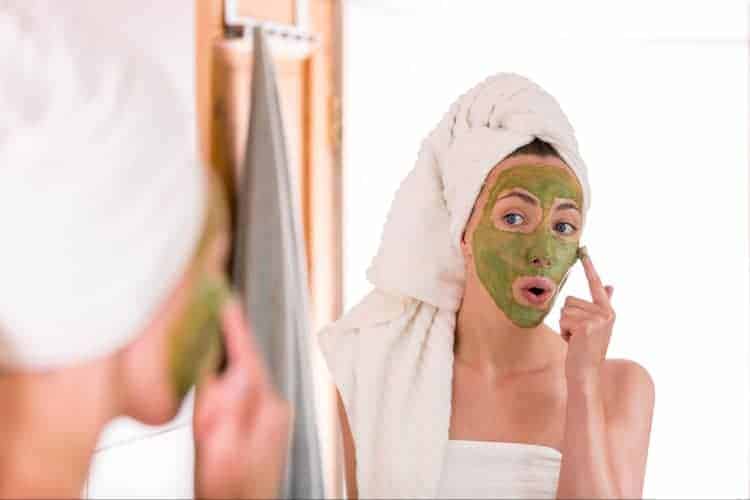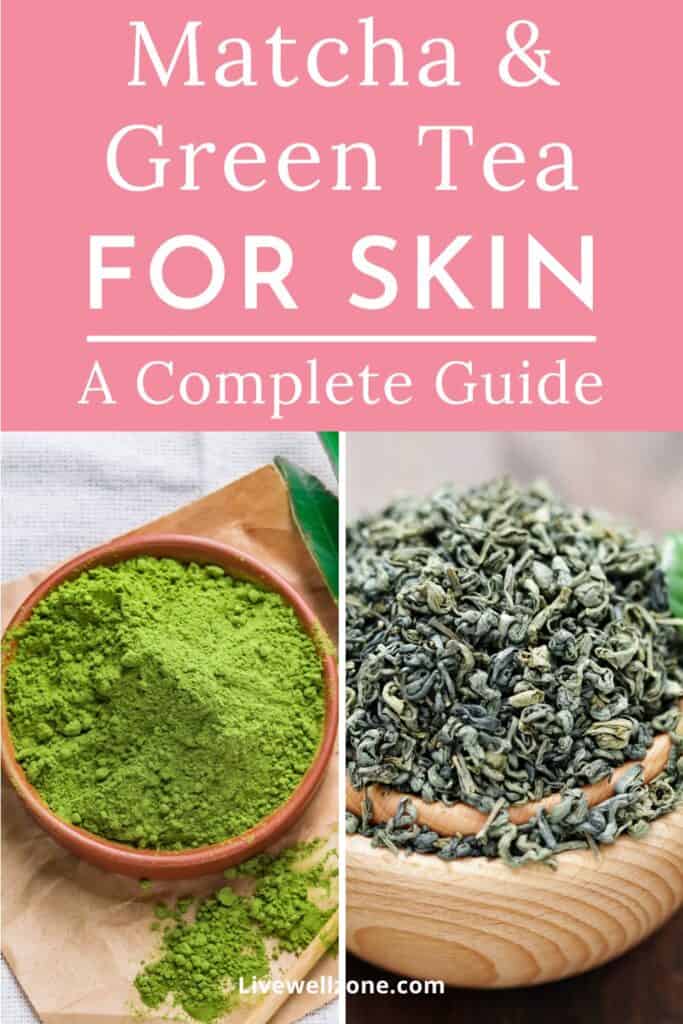
Matcha and green tea are two popular skin care ingredients that come from the same plant and provide pretty similar benefits. However, there are some important nuances when it comes to the quantity of nutrients that each provides. So, this article is going to compare green tea vs matcha for skin, so that you can get a better understanding of what each has to offer.
But before we dive into the details, there’s one main we should get out of the way:
Overall, matcha is the best type of green tea for the skin because it contains at least 3 times more antioxidants than green tea. In addition, matcha generally contains higher amounts of other nutrients that combat the inflammation and free radical damage associated with many skin conditions.
Regardless of which tea you use, one thing that makes them truly powerful is the fact that they can be used topically and internally.
So, without further delay let’s have a look at what makes matcha and green tea so amazing for the skin!
Note: this post contains affiliate links and I earn a commission (at no additional cost to you) if you use them to make a purchase.
GREEN TEA VS MATCHA FOR SKINCARE: GENERAL BENEFITS AND DIFFERENCES

| Green Tea | Matcha | |
|---|---|---|
| Can be used topically | ✓ | ✓ |
| Can be taken internally | ✓ | ✓ |
| Rich in antioxidants | ✓ | ✓ (at least 3 times more) |
| Caffeine | ✓ | ✓ (contains more) |
| Anti-inflammatory, antioxidant and antimicrobial | ✓ | ✓ |
| Astringent | ✓ | ✓ |
| L-Theanine (amino acid) | ✓ | ✓ |
| Chlorophyll | ✓ | ✓ (contains more) |
| Vitamins A, C and E | ✓ | ✓ |
General Properties
- Matcha and green tea come from the same plant as other (non-herbal) teas: camellia sinensis.
- Green tea is simply dried leaves from the camellia plant, while matcha is a powder made from ground green tea leaves.
- With green tea you consume/use an infusion (i.e. steep the tea leaves in water then strain the leaves out). With matcha, you don’t strain out the powder. You consume the tea with the powder.
Chlorophyll Content
- Chlorophyll is the phytochemical that gives green tea and matcha their signature green color.
- Matcha has more chlorophyll than green tea. This is because matcha is made only from tea leaves that grow in the shade (the plants are covered two weeks prior to harvest). As a result, the tea plant ends up with more chlorophyll (and a very vibrant green color!).
- When consumed internally, chlorophyll provides anti-inflammatory and antioxidant benefits, which can contribute to healthier skin.
L-Theanine Content
- Green tea and matcha contain the amino acid L-theanine (though matcha might actually have higher amounts).
- A study done on mice showed that topical application of L-theanine improved various factors associated with inflammatory skin conditions. Most notably, l-theanine improved erythema (redness of the skin) and lowered the production of inflammatory proteins known as cytokines (source).
- Another study done with mice revealed that topical application of green tea-derived L-theanine regulates various pathways that play a role in psoriasis (source).
Antioxidant Content
- Green tea and matcha contain a group of compounds known as catechins, which are known for having antimicrobial, astringent and antioxidant properties (1, 2, 3).
- The main catechins in green tea are epicatechin (EC), epicatechin-3-gallate (ECG), epigallocatechin (EGC) and epigallocatechin-3-gallate (EGCG). Of these, EGCG is the most abundant.
- Matcha has been shown to have a minimum of 3 times more EGCG than regular green tea (source).
Vitamin Content
- Green teas contain some skin-friendly vitamins like A, C and E. Because of this varied vitamin content, green tea may help to support collagen production, improve wrinkles, balance skin tone, improve acne scars, brighten the skin, reduce dark spots and combat free radical damage.
- Research shows that matcha tea contains double the amount of vitamin C that is found in other green teas (source). However, the amount of vitamin C that ends up in a matcha infusion depends a lot on the quality of the tea and the water temperature. Ideally, matcha should be brewed at lower temperatures of about 175°F (80°C) to preserve as many nutrients as possible.
- Matcha is the best source for vitamins A and E, especially when taken internally. With a regular green tea infusion, you won’t get much vitamin E or E since they’re not water-soluble.
NOTE: the amount of vitamin C in green teas is not as high as in store-bought products. So, don’t expect matcha to work as fast as your vitamin C serum.
Caffeine Content
- When used topically caffeine has an astringent effect that may help to reduce puffiness and dark circles.
- If you’re adding any of these teas to your skin care diet, then you’ll want to be mindful of how much caffeine you’re ingesting since it can disrupt sleep for some people.
- Green tea contains 11.3–24.67 mg of caffeine per gram (about 1/2 teaspoon), while matcha contains 18.9 and 44.4 mg of caffeine per gram (source).
HOW TO MAKE AND USE A FACE MASK WITH GREEN TEA BAGS OR MATCHA POWDER

There are two main things to keep in mind when using green teas on your face.
- First, use organically grown teas as much as possible.
- Second, when it comes to matcha, use a ceremonial grade powder like this one. Ceremonial grade matcha is considered the finest quality because it is made from the first harvest (younger leaves). These younger leaves have the highest concentration of most nutrients. Other grades – such as culinary – are made from later harvests (older leaves) and are considered less ideal from a nutritional perspective.
Now onto the face mask recipes!
Green Tea Mask (for Acne, Scars and Oily Skin)
A cup of regular green tea can be used as a substitute for water in various masks, including clay masks. Below is a quick recipe that uses clay and can be be used on acne-prone skin.
1. Steep 1 green tea bag (or 1 tsp loose leaf tea) in 1 cup of hot (175°F or 80°C) water (175°F or 80°C).
2. Mix 1 Tbsp bentonite clay with 1.5 tsp green tea and 1.5 tsp apple cider vinegar.
3. Apply the mask onto clean skin.
4. Sit back and let the mask sit on your face until it’s almost dry. Sip the remaining tea as you relax 🙂
5. Rinse off with warm water.
NOTE: If bentonite clay is too drying for you, then use 1 Tbsp kaolin clay and 1/2 Tbsp tea instead.
Matcha Powder Face Mask Recipe
Ingredients
1 tsp matcha powder
1 tsp raw honey
Instructions
1. Apply the mask onto clean skin.
2. Allow to sit on your skin for 15 – 20 minutes.
3. Rinse off with warm water.
4 MORE WAYS TO ADD MATCHA AND GREEN TEA TO YOUR BEAUTY ROUTINE
1. Pamper Your Skin With Store-Bought Green Tea Products
One of the great things about using store-bought green tea products is that you get to enjoy the tea in a blend with other super hydrating, glow-giving ingredients! Here are just a few for you to have fun with on your next at-home spa day 🙂
100% Pure Green Tea EGCG Concentrate Cream
- This green tea cream moisturizes and soothes thanks to ingredients like green tea oil, green tea concentrate, squalane and hyaluronic acid. Although it’s a cream, the product doesn’t leave a heavy residue. GET IT HERE.
ISNTree Green Tea Toner

- A soothing and hydrating formula made with 80% green tea extract, hyaluronic acid and other plant extracts (such as centalla asiatica, blueberry and white willow bark). GET IT HERE.
Teami Green Tea Detox Mask

- This ready-to-use, clarifying mask doesn’t require any mixing and features ingredients like bentonite clay, matcha, aloe leaf, and sweet almond oil. An awesome choice for acne-prone skin. GET IT HERE.
100% Pure Matcha Oat Milk Nourishing Mask
- A very soothing and hydrating blend of matcha extract, oat flour, hyaluronic acid, rose extract, coconut milk and other gentle plants. There are no weird additives or fillers. And there are no essential oils (which are irritating for some people). Note that this is a powder that you have to mix with water. GET IT HERE.
2. Make a Green Tea Toner
Although you can definitely buy fancy green tea toners, it’s also quite easy to make your own. Just follow the steps below.
- Add 1 green tea bag (or 1 teaspoon loose leaf green tea) to 1 cup of hot, distilled water (175°F or 80°C is preferable).
- Allow to steep until cool.
- Remove the tea bags/leaves.
- Pour the tea into a spray bottle or cosmetic bottle with a flip cap.
- Mist your face with the tea if you have a spray bottle, or apply the tea to a cotton pad and gently rub onto your skin.
- Store the tea in the refrigerator to keep it fresh. Use within 5 – 7 days.
Optional ingredients to add to this green tea toner are:
- 3 – 4 tablespoons apple cider vinegar: add this after the tea has cooled.
- 1 teaspoon of dried peppermint, lavender or chamomile: add this at the same time as the green tea.
3. Drink Green Tea or Matcha Daily for a Healthy Glow
Many skin issues that we experience are a reflection of systemic free radical damage and inflammation.
Therefore, drinking green teas daily is a great way to address those issues at the source because you’ll be getting regular doses of antioxidants.
To get the most health benefits it’s generally recommended that we drink:
Do keep in mind that these numbers are a general guideline and are not specifically for skin care.
So, you can start with a lower amount of tea and then adjust depending on how your skin responds.
Also, remember that green tea has caffeine (and matcha has even more).
Therefore, if you’re sensitive to caffeine, drink these teas during the earlier parts of the day. This will prevent the caffeine from disrupting your sleep.
4. Take a Daily Green Tea Supplement for Skin
If the idea of making your own toner or drinking tea doesn’t appeal to you, then you can take green tea and matcha in capsule form.
Now, while there is certainly no shortage of brands to choose from, here are the two that I recommend:
- Pure Synergy: they make these ceremonial grade matcha powder capsules that contain pure matcha (no additives or fillers). Furthermore, the matcha is organically grown so you won’t have to worry about pesticide residue (which can contribute to inflammation and subsequently, skin issues).
- Gaia: this is a good option if you want a green tea extract in a capsule. The green tea is in a liquid base within a soft capsule.
As for how much to take, it’s best to follow the manufacturer’s recommended dosage. If in doubt, you can always contact the company to see if you should adjust the dosage based on your intended use.
FAQs ABOUT USING MATCHA OR GREEN TEA FOR A HEALTHY, CLEAR COMPLEXION
Does green tea unclog pores?
Green tea has antimicrobial properties that may help to remove bacteria from clogged pores. In addition, the catechins (antioxidants) and caffeine in green tea have astringent properties that can tighten pores and potentially, reduce oiliness.
Can I rub a used green tea bag on my face?
Rubbing a used green tea bag on your face can help to soothe signs of inflammation such as redness, pimples or puffiness. To use the bags, let them cool down to a comfortable temperature for your skin. Then simply rub the tea bag onto the desired area(s) on your face.
For puffiness or dark circles around the eyes:
- Place a cooled tea bag over each eye (make sure your eyes are closed).
- Let the tea bags to sit over your eyes for up to 10 minutes.
Can I put green tea on my face overnight?
When using a green tea toner, there’s no need to rinse it off. You can leave it on your face overnight. For other green tea treatments, such as a face mask, you might be able to leave it on overnight, depending on the ingredients used.
CONCLUSION
When it comes to natural skincare, green tea is one ingredient that is definitely worth exploring, be it in the form of tea leaves, powder or supplement. For beginners, it’s best to start simple with a toner or a simple matcha and honey mask.
As you get more comfortable with these teas, you can definitely experiment more by combining them with clay, aloe vera, carrier oils, essential oils and any other natural ingredients that you like.

You Might Also Like:
A Comparative Guide to Green Tea vs Spearmint Tea for Acne
Everything You Need To Know About Chamomile Tea vs Green Tea for Acne
Spearmint Tea vs Spironolactone for Acne: Pros and Cons | Is One Better Than The Other?
Is Chamomile Tea Good For Acne? Benefits and How To Use
What To Do Before And After Steaming Your Face: A Complete Guide
What To Mix (And Not) With Rosehip Oil For Face – The Ultimate Guide
Peppermint Tea vs Spearmint Tea for Acne: Which Is Better?
How To Make The Best Anti Acne Smoothie (and Give Your Skin New Life)

